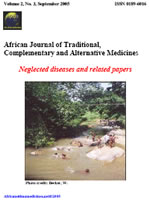
|
African Journal of Traditional, Complementary and Alternative Medicines
African Ethnomedicines Network
ISSN: 0189-6016
Vol. 12, No. 1, 2015, pp. 90-98
|
 Bioline Code: tc15013
Bioline Code: tc15013
Full paper language: English
Document type: Case Report
Document available free of charge
|
|
|
African Journal of Traditional, Complementary and Alternative Medicines, Vol. 12, No. 1, 2015, pp. 90-98
| en |
DIPEPTIDYL PEPTIDASE IV INHIBITORY ACTIVITY OF PROTEIN HYDROLYZATES FROM AMARANTHUS HYPOCHONDRIACUS L. GRAIN AND THEIR INFLUENCE ON POSTPRANDIAL GLYCEMIA IN STREPTOZOTOCIN-INDUCED DIABETIC MICE.
Soriano-Santos, Jorge; Reyes-Bautista, Raúl; Guerrero-Legarreta, Isabel; Ponce-Alquicira, Edith; Escalona- Buendía, Héctor Bernardo; Almanza-Pérez, Julio César; Díaz-Godínez, Gerardo & Romαn-Ramos, Rubén
Abstract
Background: Type 2 diabetes is a chronic metabolic disorder. Recently, dipeptidyl peptidase IV (DPP-IV) inhibitors that protect incretin hormones
from being cleaved by DPP-IV have been used as drugs to control glycemia. This study examined the potential hypoglycemic effect of amaranth grain
storage protein hydrolyzates to control postprandial glycemia in streptozotocin (STZ)-induced diabetic mice as a model system of diabetes, and their
inhibition mode on the enzyme.
Material and Methods: Amaranth grain proteins were isolated and hydrolyzed and fractionated by gel filtration. The DPP-IV inhibitory activity of
hydrolyzates as well as their kinetic parameters were assessed. Selected hydrolyzates (300 mg/kg body weight) were administered in a single
administration-study (SAS) or in the same concentration during a four-week chronic daily dosing study (FWCDDS) in order to observe the effect on
postprandial glycemia of diabetic mice.
Results: Albumin 1, Globulin and Glutelin hydrolyzates (GluH) competitively inhibited DPP-IV in vitro (Ki= 0.11-5.61 mg/mL). GluH called Glu.III
(IC50= 0.12±0.01 mg/mL) considerably inhibited DPP-IV activity. GluH identified as GluH24 improved glucose tolerance significantly (p<0.05), with
remarkable increments in plasma insulin in SAS and FWCDDS (1.25 and 2.25 mg/mL, respectively). This effect could be compared to the one
obtained from the mice group that was administered Sitagliptin (580 mg/kg body weight) as positive control (p<0.05).
Conclusion: Amaranth Glutelin hydrolyzates yielded the highest enzyme inhibitory activity reported not only in vitro, but also in the STZ-induced
diabetic mice in order to control postprandial glycemia.
Keywords
Amaranth protein hydrolyzate; DPP-IV inhibitory activity; diabetes
|
| |
© Copyright 2015 - African Journal of Traditional, Complementary and Alternative Medicines
Alternative site location: http://journals.sfu.ca/africanem/index.php/ajtcam
|
|
